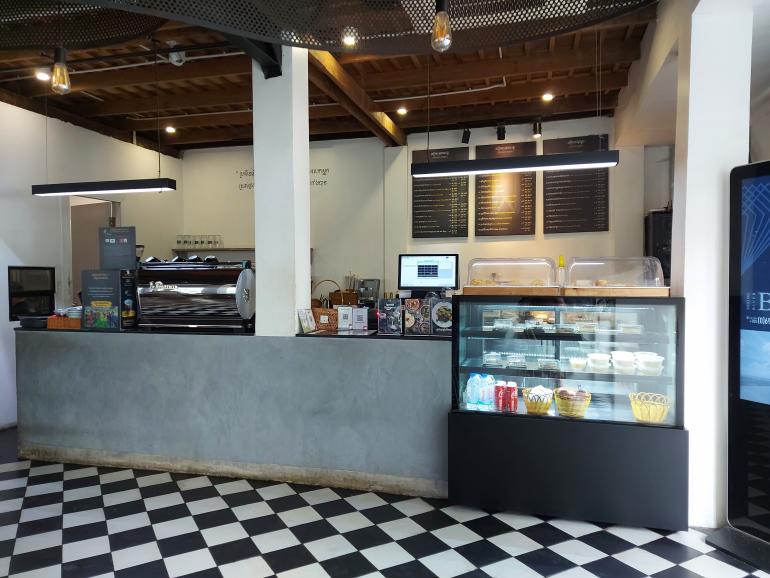Cambodia is becoming famous for coffee which is an essential caffeine boost. Among the Khmer, a typical day is kicked off by consuming a large cup of coffee. There is plenty of coffee business throughout Cambodia in terms of serving only coffee drinks, the concept of food plus coffee, coffee plus food or slight snacks, family-owned coffee cart, local-brand chain coffee, and international-brand chain coffee. Specifically, the family-owned coffee carts are a usual sight on every corner of the town. Cambodian coffee is served in various ways, served in a cup with a handle or a plastic bag with a straw, only at a $1 price.
Khmer lifestyle in drinking coffee
The coffee culture has evolved, and the market is designed to suit a variety of consumers. You will often find specialty coffee shops in towns, but the Cambodian-owned coffee carts mainly cater to the budget-conscious population. The coffee shops offer European-style coffee palettes for customers with more sophisticated pallets.
With more than half of the Cambodian population being under 25, the youth culture stares at Khmer. Most of the youths were educated overseas and craved independence. The youths prefer to hang out with friends during their leisure time and have been exposed to coffee shops. They desire a place to hang out and drink good coffee. The coffee shops offer a convenient, friendly environment for hanging out. There is a demand for quality and exceptional design, especially among the younger population. The coffee shop provides reliable Wi-Fi and a stylish decor finish with access to abundant natural light.
Due to the growing appreciation for coffee, Cambodian-owned and operated specialty coffee chain has manifested. More people have developed an interest in specialty coffee; therefore, the market is expected to grow among many Khmer coffee lovers.
Coffee vendors have customized the coffee to suit the needs of the consumers. Cambodia is a tropical climate, and most vendors do not bother with hot drinks. Iced coffee help ease the low environment. Iced coffee is a sweet and essential part of the life of the local Cambodians. Most coffee shops operating in Cambodia took many ideas from the successful coffee shops around the world and adapted them to fit the local market; that is why the Khmer coffee drinking lifestyle has been a success.
Coffee Culture in Cambodia
The coffee culture in Khmer is fascinating, with the affluent Cambodians driving particular interest in good quality coffee. Khmer outsource their coffee from neighboring Vietnam or Russia, but some farmers cultivate the crop via irrigation. 100% Robusta coffee is what is grown in Cambodia. The Khmer coffee culture has evolved with the population’s craving for a caffeine boost, causing a surge in coffee shops in the country, both local and international. The consumer market has a high demand. Cambodia is likely to emerge in the gourmet coffee market because there is increased production of coffee.
How do you make the Khmer coffee?
Traditionally, the coffee beans are first sun-dried. Sun drying the coffee beans helps enhance the sweet taste instead of the bitter taste of the coffee beans. The coffee is prepared by toasting coffee using vegetable oil until it becomes black. Once the coffee beans have been roasted, they are then grounded to produce a dark powder brewed into a vibrant cup of coffee. Coffee filters or cloth sieves are used to brew the coffee.
Brewing Cambodian iced coffee: Khmer-style iced coffee is served with condensed milk, appealing to customers who prefer sweet coffee. The ice melts to dilute the strength of the coffee, making it more bearable; Cambodian coffee is rather sweet and robust.
Why the increased coffee demand in Khmer?
There has been a noticeable growth in interest and demand for Cambodian coffee due to the availability of good quality brands of coffee, which the locals appreciate. The local coffee drinkers and the experts seem to enjoy the domestically grown coffee. The local production cannot meet the demand. This thirst for coffee is what leads to massive imports of coffee beans. Some factor that is an enormous hindrance to the production of Cambodian Coffee is the poor infrastructure in the coffee-growing regions.
By 2025, according to Market Research.com, The coffee market in Cambodia is expected to reach approximately $233.14 million and $41.73 million, for the instant coffee market and roast coffee market respectively. Annually, coffee harvest in Cambodia is around 300 tons, while more than 5,000 tons of coffee is imported yearly. The massive difference translates into the potential to up the local production capacity. Cambodia can boost productivity, and reduce the number of imports while improving exports. The economy is getting steady thanks to the consumerism culture. Coffee growing appears to be expanding, and the plantation covers will increase to up to 10,000 hectares within the next three years.
Growth of coffee shops in Khmer
Cambodia was not recognized as a coffee-drinking country until recent years. The coffee-drinking culture has surged, and in towns and particularly in the capital city, you can see coffee shops and coffee carts that offer a suitable environment for socializing and business meetings. There is growing competition for capital cafes, and foreign brands dominate the coffee market in Cambodia.

The coffee business is becoming more competitive and getting better by the day. Affluent urbanite Cambodians find foreign coffee to be very appealing, and as a result, there are many Thai-based franchises; which are favorably priced and of good quality. Most of the coffee shops are cozy and work-friendly. The coffee shops exemplify an excellent blend of hospitality, elegance, and enjoyment, with substantial menus offering high-quality complementariness.
There is the risk of many foreign coffee brands which might kill the local market. The foreign coffee businesses attract Cambodians because most Cambodians are experiencing changes in lifestyle and want to experience foreign coffee products. Additionally, most Cambodians drink coffee based on brand rather than the taste of the coffee. The market is experiencing an imbalance between Khmer coffee and foreign coffee. The local market has to up its game to stay afloat; they need to increase the variety and quality of the products and the environment. They also need to improve their marketing strategies.
The Khmer lifestyle of drinking coffee has led to significant poverty reduction, and the economy has grown. The country was previously one of the world’s poorest countries, and it is a middle-class country, and that might change for the better in the coming years. The Cambodian coffee lifestyle brings people to the aspirational culture of sophisticated coffee. Each coffee shop is a unique representation of its surrounding. More Cambodians appreciate the coffee drinking culture and lifestyle; this will boost businesses and boost the quality of services and products as the demand for coffee grows.





